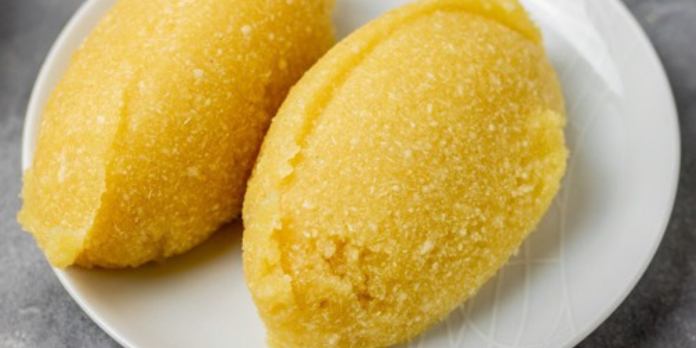Table of Contents
Swallow foods hold a special place in the heart of Nigerian cuisine, transcending regional boundaries and uniting the diverse cultures of the nation. These starchy staples, known for their ability to be easily molded into a ball and dipped into various soups, are an integral part of many Nigerian meals. In this article, we’ll explore Nigeria’s five most popular swallow foods: Tuwo Shinkafa, Semo, Pounded Yam, Amala, and Eba. Each of these swallows has a rich history, cultural significance, and unique preparation methods that make them beloved across the country. Let’s dive into the world of Nigerian swallows and discover what makes them so special.
1. Tuwo Shinkafa
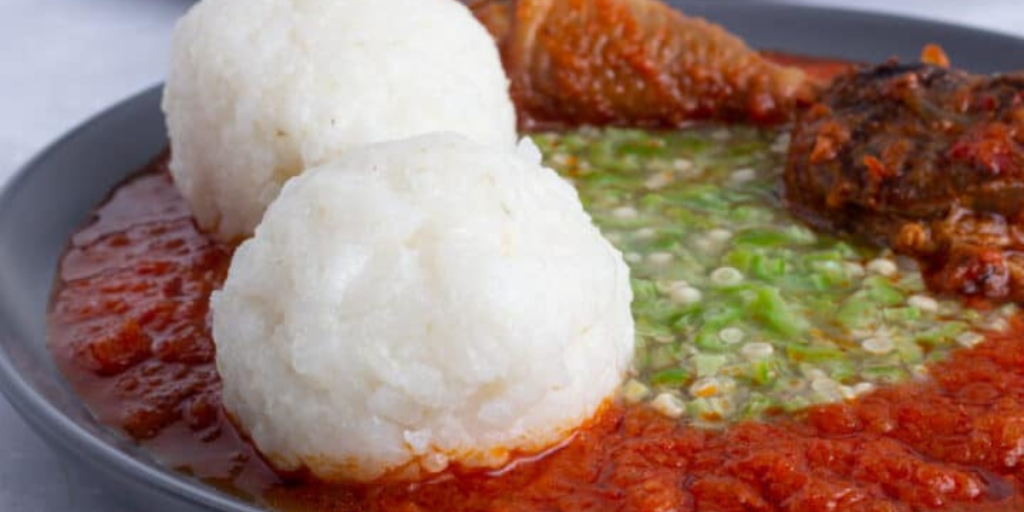
What is Tuwo Shinkafa?
Tuwo Shinkafa is a popular Nigerian swallow made from soft, short-grain rice. It is particularly common in the northern regions of Nigeria, where it is often served with a variety of local soups such as Miyan Kuka, Miyan Taushe, or Miyan Kubewa. The name “Tuwo Shinkafa” translates to “mashed rice,” which perfectly describes this swallow’s smooth and moldable texture.
Historical and Cultural Significance
Tuwo Shinkafa has deep roots in the culinary traditions of northern Nigeria. It is a staple food for many ethnic groups in the region, including the Hausa, Fulani, and Kanuri. Traditionally, Tuwo Shinkafa is served during special occasions, religious festivals, and family gatherings, symbolizing unity and togetherness. Its significance extends beyond just being a meal; it represents the hospitality and warmth of the people who prepare and share it.
Preparation Method
To prepare Tuwo Shinkafa, you need just two main ingredients: rice and water. The process begins by washing and boiling the rice until it becomes very soft. The cooked rice is then pounded or mashed until it reaches a smooth, dough-like consistency. The resulting mixture is molded into balls or other shapes, ready to be served alongside a flavorful soup.
How to Make Igbo Black soup | Best Recipe of 2024.
Nutritional Value
Tuwo Shinkafa is a carbohydrate-rich food, providing a good source of energy. It is low in fat and contains moderate amounts of protein. When paired with nutrient-rich soups, Tuwo Shinkafa can be a balanced meal that provides essential vitamins and minerals.
Popular Soups to Pair with Tuwo Shinkafa
- Miyan Kuka: A traditional soup made from powdered baobab leaves, often referred to as “baobab soup.”
- Miyan Taushe: A pumpkin-based soup, flavored with spices and often cooked with meat or fish.
- Miyan Kubewa: A soup made from dried okra, which gives it a slightly slimy texture, perfect for pairing with Tuwo Shinkafa.
Tuwo Shinkafa is more than just a meal; it is a cultural symbol of the northern Nigerian people. Its simplicity in preparation and versatility in pairing with various soups make it a beloved swallow across the nation.
2. Semo

What is Semo?
Semo, short for Semovita, is a popular Nigerian swallow made from processed wheat. It is known for its smooth texture and ability to absorb the flavors of the soup it is paired with. Semo is enjoyed across Nigeria and is particularly favored by those looking for a lighter alternative to other swallows like Pounded Yam.
Historical and Cultural Significance
Semo’s popularity grew in the 20th century as wheat-based products became more accessible in Nigeria. It quickly became a household name, especially among urban dwellers who appreciated its convenience and ease of preparation. Today, Semo is a staple in many Nigerian homes and is often served during family meals, celebrations, and gatherings.
Preparation Method
Preparing Semo is straightforward and requires semolina flour and water. The water is brought to a boil, and the semolina flour is gradually added while stirring continuously to avoid lumps. The mixture is cooked until it forms a smooth, thick dough, which is then molded into balls or other shapes. Semo is typically served hot with a variety of soups.
How To Make Benin Black soup | Best Guide of 2024
Nutritional Value
Semo is rich in carbohydrates and provides a moderate amount of protein. It is also a good source of dietary fiber, which aids in digestion. When paired with nutrient-dense soups, Semo can contribute to a balanced diet, providing essential vitamins and minerals.
Popular Soups to Pair with Semo
- Egusi Soup: A thick soup made from ground melon seeds, often cooked with leafy vegetables, meat, or fish.
- Ewedu Soup: A green, mucilaginous soup made from jute leaves, commonly enjoyed by the Yoruba people.
- Ogbono Soup: A thick, viscous soup made from ground ogbono seeds, known for its unique texture and rich flavor.
Semo has become a beloved part of Nigerian cuisine, offering a convenient and satisfying option for those who enjoy swallow foods. Its ability to complement a wide range of soups makes it a versatile choice for any meal.
3. Pounded Yam
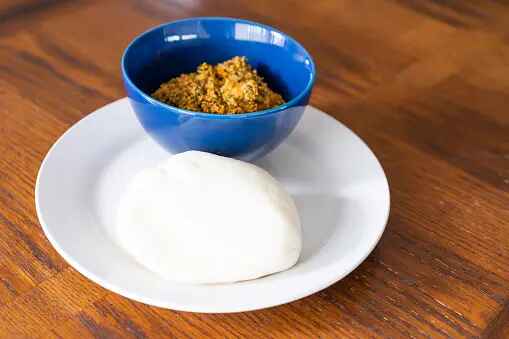
What is Pounded Yam?
Pounded Yam is one of Nigeria’s most iconic and cherished swallow foods. It is made from boiled yam that is pounded into a smooth, stretchy dough. Pounded Yam is a staple in many Nigerian households, particularly in the southwestern and central regions, where it is often served with rich, flavorful soups.
Historical and Cultural Significance
Pounded Yam has deep cultural roots in Nigeria, especially among the Yoruba and Igbo people. It is a symbol of tradition, often associated with celebrations, festivals, and important family gatherings. The labor-intensive process of pounding yam is seen as a communal activity, bringing people together to prepare and share a meal.
Preparation Method
The preparation of Pounded Yam requires yam tubers, a mortar, and a pestle. The yams are peeled, cut into pieces, and boiled until soft. The boiled yams are then pounded in a mortar using a pestle until they become smooth and stretchy. In modern times, yam pounders or mixers are often used to simplify the process. The resulting dough is shaped into balls and served with a variety of soups.
Nutritional Value
Pounded Yam is a high-carbohydrate food, providing a significant source of energy. It is also rich in dietary fiber and contains essential vitamins and minerals such as vitamin C, potassium, and magnesium. When paired with nutrient-rich soups, Pounded Yam can contribute to a balanced and nourishing meal.
Popular Soups to Pair with Pounded Yam
- Egusi Soup: A popular choice for pairing with Pounded Yam, known for its rich, nutty flavor.
- Bitterleaf Soup: A traditional Igbo soup made with bitterleaf, often cooked with meat or fish.
- Vegetable Soup (Efo Riro): A vibrant and flavorful soup made with a variety of leafy greens, often cooked with meat, fish, or crayfish.
Pounded Yam is a beloved Nigerian swallow that holds a special place in the country’s culinary heritage. Its smooth texture and ability to complement a wide range of soups make it a favorite among many Nigerians.
4. Amala
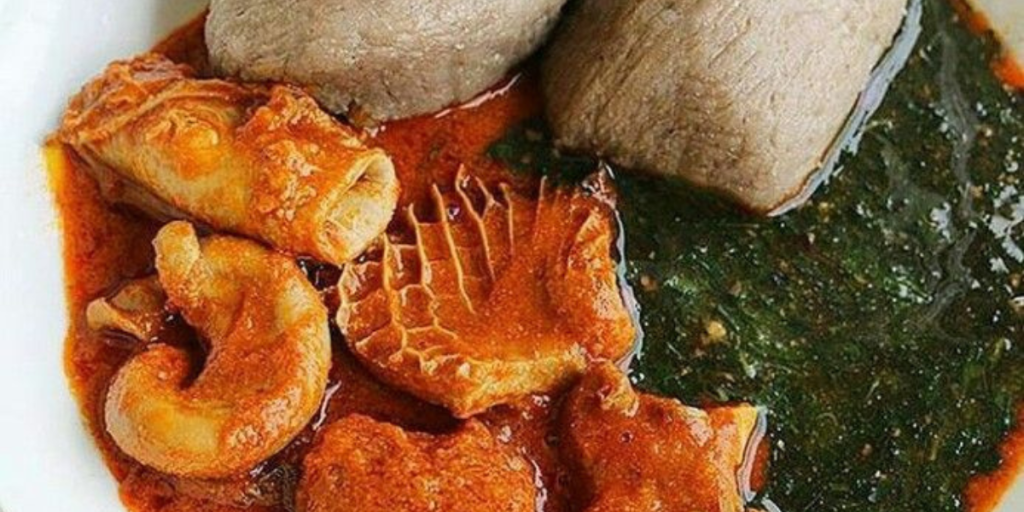
What is Amala?
Amala is a popular Nigerian swallow made from yam flour (elubo), cassava flour, or plantain flour. It is particularly common among the Yoruba people of southwestern Nigeria. Amala has a distinctive dark color and smooth texture, making it a unique and cherished part of Nigerian cuisine.
Historical and Cultural Significance
Amala is deeply rooted in Yoruba culture and is often associated with traditional ceremonies, festivals, and communal gatherings. It is a symbol of cultural pride and identity for the Yoruba people. Amala is typically served with a variety of local soups, each adding its own unique flavor to the meal.
Preparation Method
To prepare Amala, the flour (elubo) is gradually added to boiling water while stirring continuously to avoid lumps. The mixture is cooked until it forms a smooth, thick dough. The dough is then molded into balls and served hot with soup. Amala can be made from yam flour (Amala Isu), cassava flour (Amala Lafun), or plantain flour (Amala Ogede), each offering a slightly different flavor and texture.
Nutritional Value
Amala is a rich source of carbohydrates and provides dietary fiber, which aids in digestion. Depending on the type of flour used, Amala can also offer additional nutrients such as vitamins, minerals, and antioxidants. When paired with nutrient-dense soups, Amala contributes to a balanced and nourishing meal.
Popular Soups to Pair with Amala
- Ewedu Soup: A classic Yoruba soup made from jute leaves, often enjoyed with Amala and Gbegiri (bean soup).
- Gbegiri Soup: A smooth and creamy soup made from blended beans, commonly paired with Ewedu and Amala.
- Ogbono Soup: A thick, viscous soup made from ground ogbono seeds, known for its rich flavor and unique texture.
Amala is a staple in Yoruba cuisine and a beloved Nigerian swallow. Its distinctive flavor, smooth texture, and ability to complement a wide range of soups make it a favorite among many Nigerians.
5. Eba
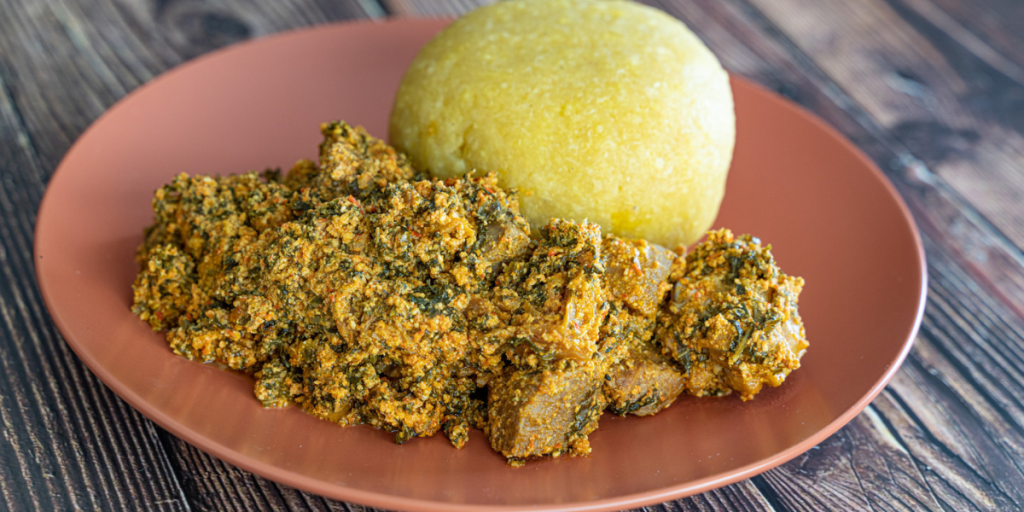
What is Eba?
Eba, also known as Garri, is one of Nigeria’s most popular and widely consumed swallow foods. It is made from cassava flakes (garri) that are mixed with hot water to form a smooth, moldable dough. Eba is enjoyed across Nigeria and is known for its versatility and ease of preparation.
Historical and Cultural Significance
Eba has a long history in Nigerian cuisine, particularly among the Yoruba and Igbo people
. It is a staple food in many households and is often served during family meals, celebrations, and communal gatherings. Eba’s affordability and accessibility have made it a popular choice for people of all socioeconomic backgrounds.
Preparation Method
To prepare Eba, garri is gradually added to boiling water while stirring continuously until it forms a smooth, thick dough. The dough is then molded into balls or other shapes and served hot with a variety of soups. Eba can be made from white or yellow garri, with yellow garri being flavored with palm oil for added richness.
Nutritional Value
Eba is a carbohydrate-rich food that provides a good source of energy. It is also a source of dietary fiber, which aids in digestion. Depending on the type of garri used, Eba can also offer additional nutrients such as vitamins and minerals. When paired with nutrient-dense soups, Eba contributes to a balanced and nourishing meal.
Popular Soups to Pair with Eba
- Okra Soup: A popular soup made from okra, often cooked with leafy greens, meat, or fish.
- Egusi Soup: A thick, rich soup made from ground melon seeds, commonly paired with Eba.
- Afang Soup: A traditional soup from the Efik and Ibibio people, made with Afang leaves and waterleaf.
Eba is one of Nigeria’s most popular and widely consumed swallow foods. Its ease of preparation, versatility, and ability to complement a wide range of soups make it a favorite among many Nigerians.
Conclusion
Swallow foods are an integral part of Nigerian cuisine, each with its own unique history, cultural significance, and preparation method. Tuwo Shinkafa, Semo, Pounded Yam, Amala, and Eba are five of the most popular swallows in Nigeria, enjoyed by people of all ages and backgrounds. These swallows are more than just meals; they are symbols of tradition, community, and cultural pride. Whether enjoyed during a festive celebration or a simple family meal, these swallows continue to bring people together and celebrate the rich culinary heritage of Nigeria.
















